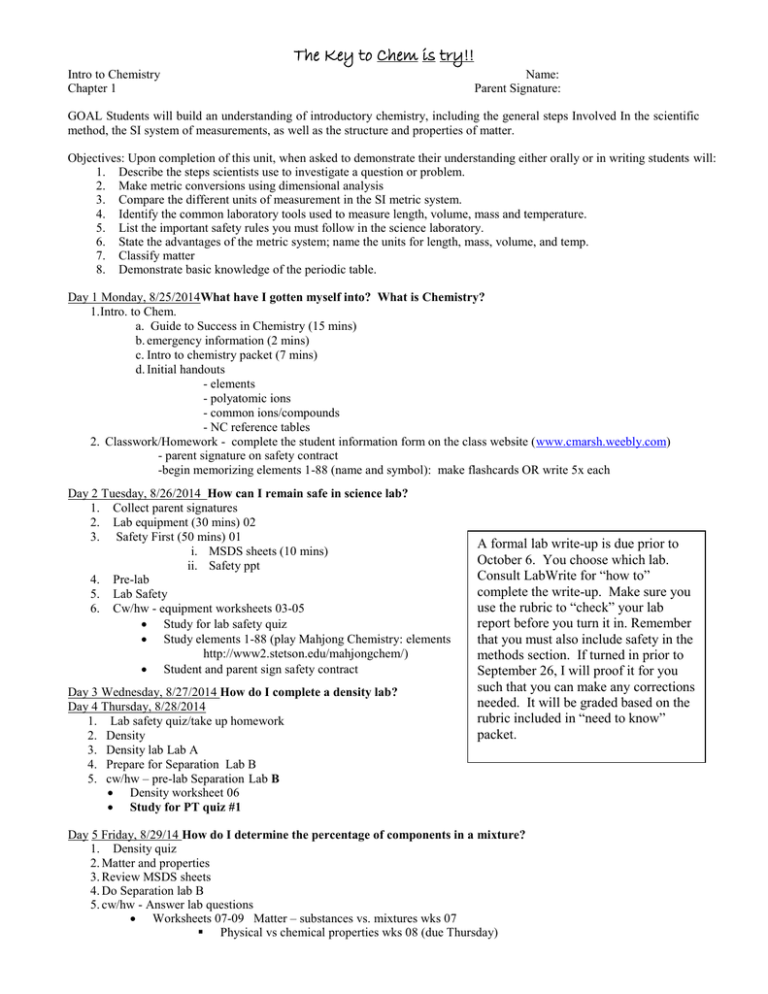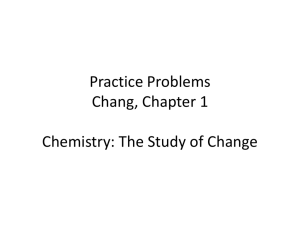Intro to Chemistry
advertisement

The Key to Chem is try!!
Intro to Chemistry
Chapter 1
Name:
Parent Signature:
GOAL Students will build an understanding of introductory chemistry, including the general steps Involved In the scientific
method, the SI system of measurements, as well as the structure and properties of matter.
Objectives: Upon completion of this unit, when asked to demonstrate their understanding either orally or in writing students will:
1. Describe the steps scientists use to investigate a question or problem.
2. Make metric conversions using dimensional analysis
3. Compare the different units of measurement in the SI metric system.
4. Identify the common laboratory tools used to measure length, volume, mass and temperature.
5. List the important safety rules you must follow in the science laboratory.
6. State the advantages of the metric system; name the units for length, mass, volume, and temp.
7. Classify matter
8. Demonstrate basic knowledge of the periodic table.
Day 1 Monday, 8/25/2014What have I gotten myself into? What is Chemistry?
1.Intro. to Chem.
a. Guide to Success in Chemistry (15 mins)
b. emergency information (2 mins)
c. Intro to chemistry packet (7 mins)
d. Initial handouts
- elements
- polyatomic ions
- common ions/compounds
- NC reference tables
2. Classwork/Homework - complete the student information form on the class website (www.cmarsh.weebly.com)
- parent signature on safety contract
-begin memorizing elements 1-88 (name and symbol): make flashcards OR write 5x each
Day 2 Tuesday, 8/26/2014 How can I remain safe in science lab?
1. Collect parent signatures
2. Lab equipment (30 mins) 02
3. Safety First (50 mins) 01
i. MSDS sheets (10 mins)
ii. Safety ppt
4. Pre-lab
5. Lab Safety
6. Cw/hw - equipment worksheets 03-05
Study for lab safety quiz
Study elements 1-88 (play Mahjong Chemistry: elements
http://www2.stetson.edu/mahjongchem/)
Student and parent sign safety contract
Day 3 Wednesday, 8/27/2014 How do I complete a density lab?
Day 4 Thursday, 8/28/2014
1. Lab safety quiz/take up homework
2. Density
3. Density lab Lab A
4. Prepare for Separation Lab B
5. cw/hw – pre-lab Separation Lab B
Density worksheet 06
Study for PT quiz #1
A formal lab write-up is due prior to
October 6. You choose which lab.
Consult LabWrite for “how to”
complete the write-up. Make sure you
use the rubric to “check” your lab
report before you turn it in. Remember
that you must also include safety in the
methods section. If turned in prior to
September 26, I will proof it for you
such that you can make any corrections
needed. It will be graded based on the
rubric included in “need to know”
packet.
Day 5 Friday, 8/29/14 How do I determine the percentage of components in a mixture?
1. Density quiz
2. Matter and properties
3. Review MSDS sheets
4. Do Separation lab B
5. cw/hw - Answer lab questions
Worksheets 07-09 Matter – substances vs. mixtures wks 07
Physical vs chemical properties wks 08 (due Thursday)
Physical vs. chemical changes wks 09 (due Thursday)
Write the elements and symbols 5 times each
Day 6 Tuesday 9/2/2014 What are three ways to determine if a chemical change has occurred?
1. go over/check homework
2. Review safety for Let’s get chemical lab C
3. Let’s get chemical lab C
4. cw/hw – Answer questions for Let’s get chemical lab C
Make flashcards OR write elements 21-30 5x each!!
Day 7 Wednesday 9/3/14 What are the basic metric units?
1. Go over homework
2. Discuss Let’s get chemical lab C
3. Dimensional analysis
4. Metrics
5. cw/hw -Dimensional analysis worksheet (Factor Label Method) 10
Day 8 Thursday 9/4/14 How do I solve a problem using dimensional analysis?
Note:
1. Go over homework
l dm3=1 L
2. Counting Atoms - activity
lmL = lcc=lcm3
3. Dimensional analysis/metrics
4. cw/hw - Metric and measurement 11
Dimensional analysis worksheet 12
Make flashcards for PT quiz #1 (and use them)
{3 bonus points for having a parent/guardian help you study – bring a signed note}
Day 10 Friday 9/5/14 How can I demonstrate mastery of dimensional analysis?
1. PT quiz #1
2. Review
3. Expectations for packet
4. cw/hw – STUDY for test
Complete review sheet 13
Day 11 Monday 9/8/14 How can I demonstrate my mastery knowledge of the introduction to chemistry?
1. Test
2. Homework.
study for PT quiz #8
Pre-Lab: questions to answer before doing the lab
For more information on Pre-Labs, go to: http://www.ncsu.edu/labwrite/
1. Establishing the learning context for the lab.
What is the scientific principle (theory or concept) that you are supposed to be learning about by doing the lab? (You'll probably be
able to figure this out by checking the lab manual for the title of the lab and the introduction to the lab.) What are we studying in
class that this lab will help you learn? Please explain/define the class topic to be studied through this lab
2. Establishing the goals of the lab.
a. List the objectives for the lab. (The objectives are the concrete acts you are supposed to perform in the lab, such as to
measure something, to analyze something, to determine something, to test something, etc.) What will you accomplish
completing this lab?
b. Summarize the procedures for the lab. (Give enough details that you could carry out the lab)
3. Establishing a safe lab environment.
a. Name the chemicals/equipment being used in the lab and the precautions that should be taken with each.
b. Name any additional safety concerns/precautions that should be addressed before doing the lab. (Wear goggles, apron,
be careful near open flame, etc.)
4. Establishing your hypothesis for the lab.
a. State your hypothesis for the outcome of the lab procedure. Contrary to popular opinion, a hypothesis is more than
an educated guess. It describes a predicted relationship of the dependent variable(s) to the independent variable(s)
based on information that you know or gather. Your hypothesis must be based on reasoning, not guessing!
b. Explain the reasoning that has led you to your hypothesis. (Your reasoning should be based on what you know
about the scientific principle the lab is about.)
POGIL
Laboratory Safety Diagram
01
Lab B
Separation Lab
Question:
How do you go about separating a mixture of sugar and sand so you can determine the percentage of sand in the mixture?
Extra-credit will be given to students who can correctly determine the percentage of each substance.
Materials:
Packet containing a mixture of iron fillings, sugar and sand
Procedure:
In this laboratory exercise you will, analyze a mixture of sugar and sand to determine the
percentage of sand in the mixture. You will be given a packet of the mixture and will be
expected to make your determination solely on the basis of the one packet. (You will be charged
10 points for another bag.) Think about variables that could influence your results. Keep
accurate and complete records. Laboratory notebooks are subpoenable in a court of law, thus
you might be called upon to defend the accuracy of your results. Think about the data you will
need in order to realize the purpose of the experiment and how you will go about gathering that
data. Remember, when you are on the witness stand, an attorney is going to ask you how you
know that your results are correct? Good Luck. Work Safely!
Summing Up:
1.
Outline the procedures you followed in separating the sugar and the sand. Be specific.
2.
Prepare a list of places in which error could have entered into your methods. Be as
detailed as possible.
3.
Show your calculations for determining the Percentage of sand in your mixture. Be sure
to include units on all of your numbers.
4.
How could you determine the percentage of sugar in your sample? Show your
calculations here.
5.
If you could carry out this experiment a second time, what would you do differently to
get better results?
Lab C
Let’s Get Chemical
Concept Development
Question:
What characteristics distinguish a chemical change from a physical change?
Materials:
0.1
M FeCl3
Bunsen burner
0.1
M NaCl
Test tubes
0.1
M KSCN
Wood splints
0.1
M AgNO3
wax
6M
HC1
Mossy zinc
Hazard Warning:
Wear safety goggles throughout this entire experiment. FeC1 3 and KSCN are poisonous. Hydrochloric acid, HCl, is
extremely corrosive and can cause burns to the skin and eyes. Wash hands before leaving lab area.
Procedure:
Change in a substance can be classified as a physical change or a chemical change. A physical change results in a change of physical
properties without a change in the chemical properties or chemical composition. A chemical change results in the formation of a new
substance with a new chemical composition. The new substance can have different physical and chemical, properties.
In this activity you will observe chemical and physical changes. Before beginning the experiment, you must
construct your own data table in which to record your observations. You will carry out each experiment and then
must decide whether each event is a physical change or a chemical, change.
1.
Read through the changes explained in 2-4 below. Prepare a data table in which you can record
observations of changes and whether the change is a chemical change or a physical change. Do not begin
the experiment before completing your table.
2.
Heat about 1 gram of wax in a test tube until it melts. Record the mass before and after heating. Repeat the
procedure, but this time use a wood splint instead of the wax.
3.
In a test tube mix 2 mL FeCl3 and 2 mL KSCN. Caution: FeCl3 and KSCN are poisonous. Repeat the
procedure using FeCl3, and NaCl. Repeat using FeCl3, and AgNO3. Remember to record your observations
in the data table.
4.
In a test tube add a piece of mossy zinc to 3 mL of 6 M HCl. Note the change in temperature of the test
tube.
Summing up:
1.
In which situations were chemical, changes occurring?
2.
In which situations were physical changes occurring?
3.
Write a list of guidelines that you can use to distinguish a physical change from a chemical change.
U1W06: Density
Show all work using UKPS method. You get no credit for just showing the answer.
1. An aluminum bar with a volume of 35 cm3 has a mass of 94.5 g. What is the density of the
aluminum based on this information?
2.7 g/cm3
2. If the aluminum bar is cut in half, what is the mass, volume, and density of half of the bar?
47g,
18 cm3,
2.7 g/cm3
3. A glass tube that holds exactly 75.0000 mL is filled with liquid mercury metal whose mass is
shown to be 1020.0011 g. From these data, what is the density of mercury metal?
13.6000
g/mL
4. The mass of 155 mL of ethyl alcohol is found to be exactly 122.5 g. What is the density of ethyl
alcohol?
5. A block of ice with a mass of 519.0 g is found to occupy a volume of 565.8 cm3. What is the
density of the ice?
6. Find the density of a sample of silicon which raises the water level of a graduated cylinder from
250.0 cm3 to 485.7 cm3 and has a mass of 570.44 g.
7. Calculate the density of carbon monoxide gas if 24.56 L of the gas has a mass of 30.7 g.
8. A 5.00 g sample of ether is found to have a volume of 6.76 mL. From these data calculate the
density of ether.
0.720 g/mL
0.9173 g/cm3
2.42 g/cm3
1.25 g/L
0.740 g/mL
9. What is the mass of a block of tungsten metal which has a volume of 83.92 cm3? (Hint: Look up
the density of tungsten. Beware of Google search trying to give you tungsten carbide.)
1615 g
10. A solid cube of impure zinc metal, 3.50 cm on a side, has a density of 6.95 g/cm3. What is the
mass of the cube?
298 g
11. A brass bar, density 8.69 g/cm3, has a mass of 176 g. What is the volume of this brass bar?
20.3 cm3
12. An irregular shaped piece of pure gold has a mass of 428 g. What is the volume of this piece of
gold?
22.2 cm3
U1W9: Physical & Chemical Changes
In a physical change, the original substance still exists; it has only
changed in form. Energy changes usually do not accompany
physical changes, except in phase changes and when substances
dissolve.
In a chemical change, a new substance is produced. Energy
changes always accompany chemical changes. Chemical changes
are always accompanied by physical changes.
Classify the following as examples of a physical change or a
chemical change.
1.
Sodium hydroxide dissolves in
water.
__________________
2.
3.
Hydrochloric acid reacts with
sodium hydroxide to produce a
salt, water, and heat.
__________________
A pellet of sodium is sliced in two.
__________________
4.
Water is heated and changed to
steam.
__________________
5.
6.
Potassium chlorate decomposes to
potassium chloride and oxygen
gas.
__________________
Iron rusts.
__________________
7.
Ice melts.
__________________
8.
Acid on limestone produces carbon
dioxide gas.
__________________
9.
Milk sours.
__________________
10. Wood rots.
__________________
U1W11: Metric Conversion
Answers: 1: 0.35 dL, 2: 0.950 kg, 3: 27.5 cm, 4: 1 kL, 5: 1 L, 6: 4.5 g, 7: 250 mm, 8: 0.5 dag, 9: 7.5 cm,
10: 15 000 mg (Show UKPS work to get credit.)
U1W12: Dimensional Analysis Practice
Useful Conversions:
16 oz = 1 lb
1 in = 2.54 cm
1 kg = 1000 g
15 birds = 1 dog
1 oz = 28.35 g
1 ft = 12 in
1 m = 1000 mm
6 birds = 1 cat
1 kg = 2.2 lbs
1 mile = 1.61 km
1 m = 100 cm
4 birds = 1 frog
1 L = 1.06 qts
1 mile = 1760 yds
1 m = 10 dm
1 gallon = 4 qts
1 L = 1000 mL
1 ton = 2000 lbs
Perform the conversions using dimensional analysis. Show all work in UKPS format!
1. 3.61 lbs to kg
10. 0.821 qts to mL
2. 0.43 oz to grams
11. 81.6 mL to qts
3. 860.0 g to pounds (lbs)
12. 30.2 L to gal
4. 4760 kg to tons
13. 243 cm3 to dm3
5. 83.6 in to cm
14. 2.07 m3 to cm3
6. 713 ft to meters
15. 7 dogs to cats
7. 27.3 m to in
16. 4 cats to frogs
8. 0.635 mm to inches
17. 3 frogs to dogs
9. 3.17 gal to liters
18. Extra Credit: A latex semi-gloss enamel is advertised as having a coverage of 450 ft2/gal when used
on sealed surfaces. What is the average thickness of a coat of paint in millimeters?
Answers: 1: 1.64, 2: 12 g, 3: 1.896 lbs, 4: 5.25 tons, 5: 2.12E2 cm, 6: 2.17E2 m, 7: 1.07E3 in, 8: 2.50E-2
in, 9: 1.20E1, 10: 7.77E2, 11: 8.62E-2, 12: 7.98, 13: 0.243, 14: 2070000, 15: 20, 16: 6, 17: 0.8
Lab
Report
Writer:
Poor
Fair
Excellent
Section
Scores
Section Weights
5
Title
Describes lab content concisely, adequately, appropriately
0%
1a
Abstract
Summarizes the gist of each part in proper order
Conveys a sense of the full report concisely and effectively
0%
2a
2b
Introduction
Successfully establishes the learning context
Effectively presents the goals of the report
States hypothesis and provides logical reasoning for it
0%
3a
3b
3c
Materials and methods
Identifies all key materials used in lab procedure
Presents a clear and concise description of lab procedure
Gives enough details to allow for replication
Addresses safety concerns for lab
0%
4a
4b
4c
4d
Results
Opens with effective statement of overall findings
Presents visuals clearly, accurately, without redundancy
Presents verbal findings clearly and with sufficient support
Successfully integrates verbal and visual representations
0%
5a
5b
5c
5d
Discussion
Opens with effective comparison of results and hypothesis
Provides sufficient and logical explanation for comparison
Sufficiently addresses other issues pertinent to lab
0%
6a
6b
6c
Error Analysis
Possible errors that could have occurred
How did the error(s) affect your results?
What you could do to reduce your error?
0%
Conclusion
Directly addresses what has been learned in the lab
Provides enough details to be convincing
0%
Presentation
Citations and references adhere to proper format
Format of tables, graphs, drawings is correct
Report is written in scientific style: clear and to the point
Verb tenses are appropriate to each section
Report is grammatically
correct
Report is clear of spelling
errors
0%
Overall aims of the report: the student...
Has successfully learned what the lab is designed to teach
Demonstrates clear and thoughtful scientific
inquiry
Applies procedures effectively to arrive at expected outcomes
0%
5
10
10
15
15
10
10
7a
7b
10
8a
8b
8c
8d
8e
8f
10
9a
9b
9c
100
Final
Grade
0%





